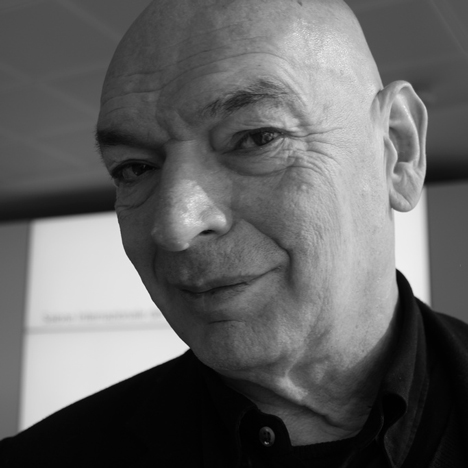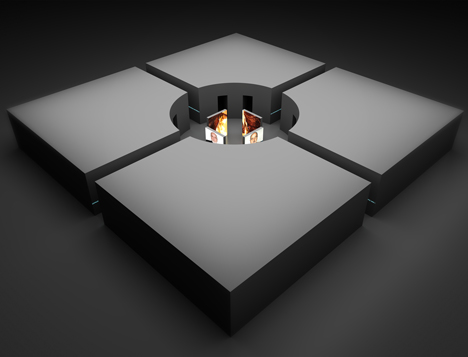
"Apartments make better places to work than offices" - Jean Nouvel
Milan 2013: French architect Jean Nouvel will curate an exhibition of office spaces in Milan in April, presenting a range of scenarios to replace the "grey cultural world" of purpose-built offices (+ interview).
"Very often now, our apartments make better places to work," Nouvel told Dezeen at the preview of the exhibition in Milan yesterday. "The opposite is right too: often it is better to live in the space designed to be an office."
The installation, called Project: Office for Living, will present eight alternative working environments, with the first three representing a Milanese apartment, a loft and an industrial hangar repurposed as work spaces.
"All of these are new conditions to create space for offices," said Nouvel. "We don’t have to repeat and to clone exactly the same organisation and the same furniture for everyone."
At the centre of the installation, a violently ripped-apart system of standard workstations will represent his rejection of bland corporate environments. "The office today is a repetition of the same space for everyone," he says. "General solutions are bad solutions for everyone."
The Project: office for living installation will be on show in pavilion 24 of SaloneUfficio at the Salone Internazionale del Mobile in Milan from 9 to 14 April 2013.

Above: visualisation of layout for Project: office for living
For skyscrapers, Nouvel advocates flexible spaces that can be reconfigured to suit individual workers: one section of the installation will feature pools of illumination that can be individually altered rather than generic overhead lighting, another will showcase furniture that can be reconfigured like Lego building blocks and a third is partitioned by mobile screens.
Classic furniture by designers Nouvel admires including Jean Prouvé and Charlotte Perriand will be showcased alongside contemporary examples from elsewhere in the furniture fair and Nouvel suggests that furniture companies should make less distinction between domestic and commercial products: "I want people to imagine that furniture for offices is also for the home."
See Nouvel's Project: Office for Living installation at the Salone Internazionale del Mobile 2013 in Milan here.
Portrait is by Barbara Chandler.
Here's an edited transcript of the interview with Jean Nouvel:
Rose Etherington: You've called the project Office for Living. What do you mean by that?
Jean Nouvel: We spend more and more of our lives in work places than at home and it shows a kind of contradiction because for a lot of people, to work is not to live.
Very often now, our apartments make better places to work. And the opposite is right too: often it is better to live in the space designed to be an office. I want people to imagine that furniture for offices is also for the home.
Rose Etherington: What’s wrong with office design?
Jean Nouvel: The office today is a repetition of the same space for everyone. You have a frame and you have the right to a number of squares in this frame, so it's only a functional and rational approach. General solutions are bad solutions for everyone. This arrived at a very grey cultural world and what I want to show is that now we will have new adaptations of the cities.
It’s possible now to work in other places than the traditional office buildings with glass. It's right to reuse buildings: all these [traditional] buildings at the entrance of the city or corrugated metal structures at the edge; all of these are new conditions to create space for offices. What is important now is to show that we will probably work in different conditions.
You can imagine different buildings are empty and they could become your office and we don’t have to repeat and to clone exactly the same organisation and the same furniture for everyone.
Rose Etherington: I'm told that you prefer to work at home or in a restaurant. What do you get from those environments that you don’t get from the office in Paris?
Jean Nouvel: It’s quieter and if I have to think with a team in a seminar or something I don't have to have so many people around and all the noises of the city. So I do it in a quieter place, a more agreeable place. But it depends on the nature of your work.
We’ve talked about "tele-travail" since a long time. You can work at home but you can also work in every place, so every person has to invent his natural office. We will see one of the offices of Philippe Starck in the installation and he works by the sea.
When we do an exhibition like this, it is to talk to people who want to think about the question of offices: the companies designing all the material but also people researching their needs and which kind of furniture they will take.
So the idea is to show that now we do not have to stay in this frame and it's possible to think in another way in relation to the natural world and empty spaces in the city. I just want to open these new conditions.
Rose Etherington: How have you put this into practice in offices you designed?
Jean Nouvel: The CLMBBDO [advertising agency in Paris] was such a special commission because I was commissioned by Philippe Michel, one of the most famous creatives of advertising in the '80s and '90s and he wanted to create this new office.
He said to me: “I want to put out the traditions of the stupid office like I had all my life. We are free and I want a building without an edge.” He said: “Okay, I don't want a building for the future. I don't want a building of yesterday. I want to do what is the most agreeable and the most fulfilling for a sense of wellbeing.”
And we arrived at this building along the Seine with balconies. You can open all the façades, you can work outside or you can work inside. When the weather was good, you could open the roof.
You could put the offices in different spaces and you can have flexibilities on each floor. With the furniture, you could walk on every seat and you could sit on the backs. Sometimes the central space was for work, sometimes that was a space to have meetings or to do sport. All of that was completely free.
Rose Etherington: Lots of creative and technology companies have offices with places for play as well as work, almost like playgrounds.
Jean Nouvel: The programme is very important, of course, and you have to imagine spaces for the expressions of the people. We design offices now with one wall where you can do what you want and it becomes a big screen with music or with your preferred image. In my office, for example, nobody controls if you are here or not here, how long you stay and so on. So it's also one possible way to work.
When someone can have a break, it's not only to drink a coffee but it could be to do exercise or to meet people. When you work for five or six hours, sometimes you need to find contrast and then you work in a better condition and you are more efficient.
But like in all my work since the beginning, I don't think we research one ideal solution. We don't want to have standard conditions and impose these conditions in every city in the world. We just show some examples.